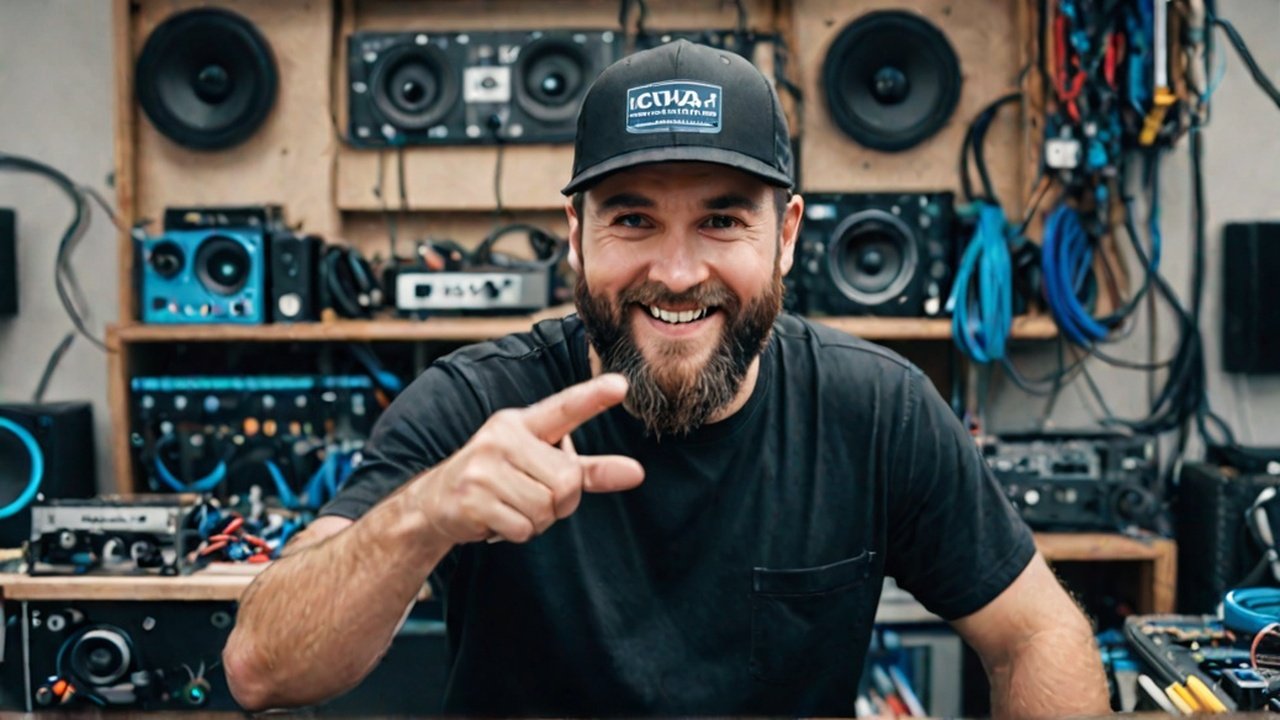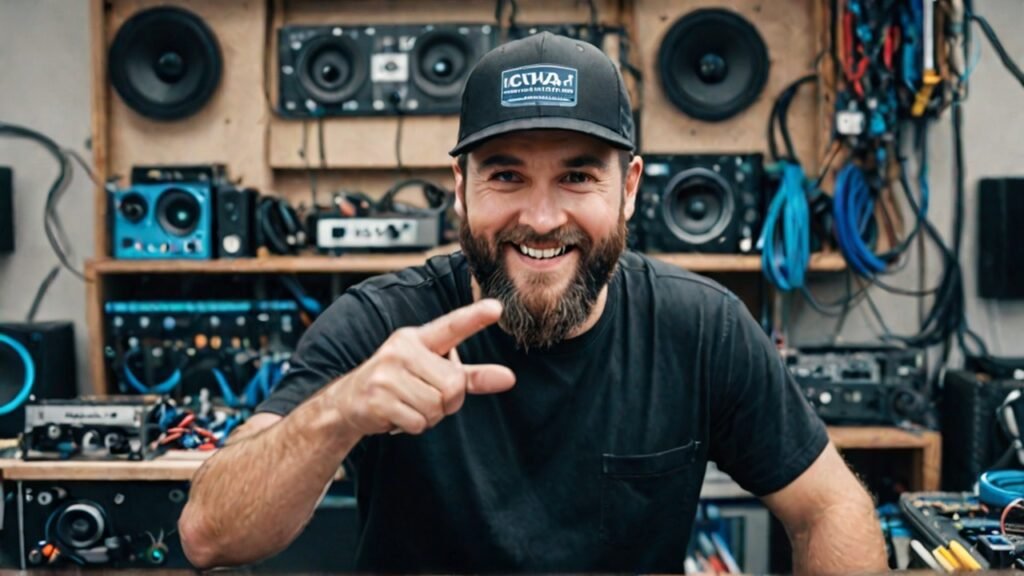
Feeling overwhelmed by DACs, amps, impedance, and endless headphone models? You’re not alone. Audio equipment forms an integral part of how we experience music, movies, games, and even work calls. Stepping into this world can feel like deciphering a foreign language, especially with choices seeming endless – from sleek wireless earbuds to robust home theater systems. But here’s the secret: You don’t need a Ph.D. in acoustics or a bottomless bank account to unlock significantly better sound.
This guide cuts through the jargon and confusion to help you, the beginner, find your perfect starting audio setup – simple, affordable, and tailored to how you live and listen. Forget chasing the most expensive gear; it’s about how each component comes together to match your personal preferences, environment, and budget. Let’s build your sound sanctuary!
Forget Perfection, Start Simple & Essential
The biggest beginner audio setup mistake is overcomplicating things or chasing an unrealistic “endgame” right away. Your perfect setup isn’t about specs; it’s about what works for your ears, your space, your budget, and your favorite sounds. It’s about balancing expectations with practical availability.
Focus on the essential audio gear that forms the backbone:
- Headphones/Speakers: Your transducers – turning electrical signals into sound.
- Source: Where your sound originates (Phone, PC, TV, Turntable, Streamer).
- Amplification (Sometimes): Boosting the signal to drive speakers/headphones.
- Basic Cables: Reliable connections.
CLICK HERE FOR ALL YOUR HOME SOUND NEEDS
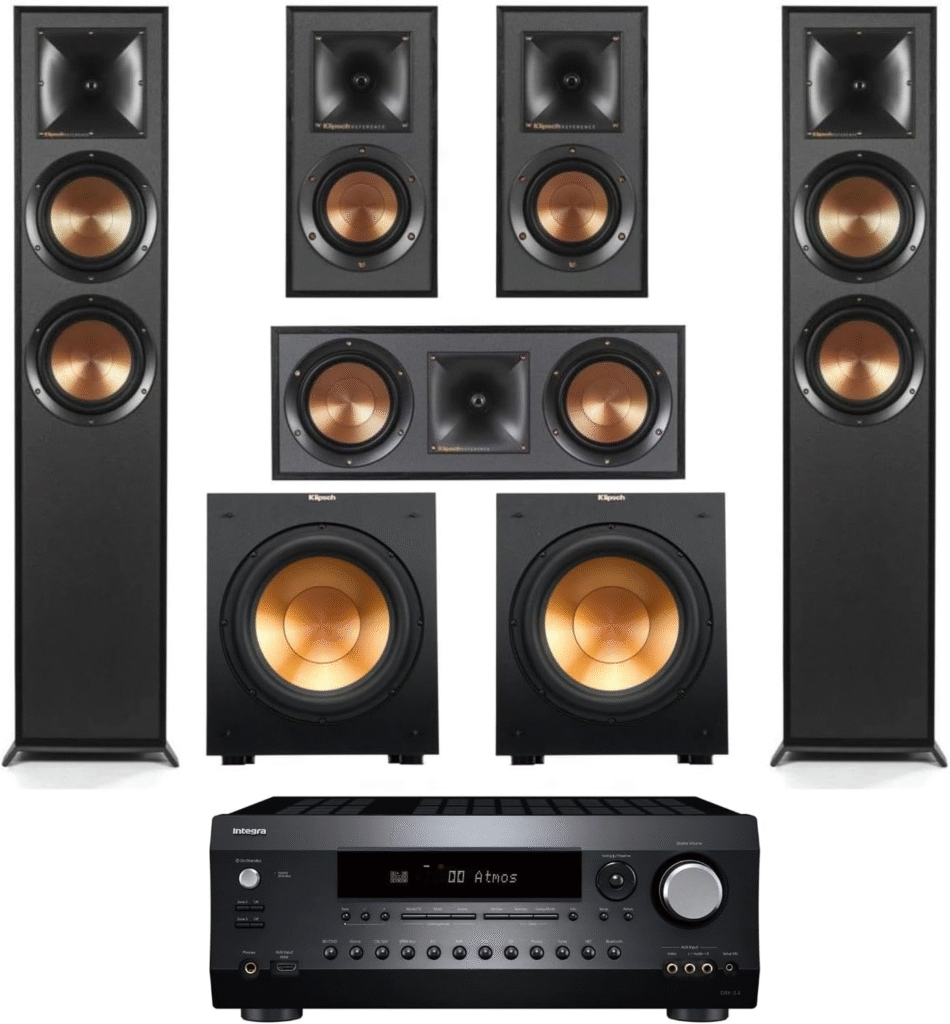
Step 1: Know Thyself – Defining Your Audio DNA
Before browsing, answer these core questions to define your “audio DNA”:
- What’s Your Primary Sound Source? (Where does the sound originate?)
- Computer/Laptop: Focus on headphones or small speakers for a desktop audio setup beginner.
- Smartphone/Tablet: Prioritize portable headphones/IEMs or a simple PC audio upgrade if docked. Consider improving phone audio quality cheap with a dongle DAC.
- TV: Explore soundbars or compact speakers for a budget TV sound upgrade.
- Turntable: You’ll need speakers (and likely an amp/phono stage).
- Streaming Device: Consider how it connects to your output.
- Where Will You Listen? (Your Environment is Key!)
- At Your Desk: Bookshelf speakers for beginners or headphones reign supreme. Space is limited; acoustics matter.
- Living Room: Needs sound that fills the space – small room speaker setup or a soundbar. Think about room interaction (hard floors vs. carpets).
- On-the-Go/Commuting: Portability and noise isolation are critical (IEMs or closed-back headphones).
- Bedroom/Quiet Space: Open-back headphones or small speakers could shine. Prioritize comfort.
CLICK HERE FOR YOUR AUDIO DEALS
- What Are You Listening To? (Priorities Define Gear)
- Music: Genres matter! Bass-heavy electronic needs different gear than delicate classical. Prioritize clarity, impact, or soundstage?
- Movies/TV: Clear dialogue and immersive effects are king. A soundbar or 2.1 system might be ideal (best sound for movies beginner).
- Gaming: Positional audio is crucial. A good audio setup for gaming beginner focuses on headphones with a mic or speakers with precise imaging.
- Podcasts/Audiobooks: Speech clarity and long-term comfort are paramount.
- What’s Your Realistic Budget?
- Be honest! Good sound exists at $100, $250, $500. Setting a clear audiophile starter kit budget prevents disappointment. Focus on starting audiophile on a budget and upgrading later. Good audio cheap beginner setups are achievable!
- Wired vs. Wireless: The Eternal Trade-Off
- Wireless (Bluetooth): Ultimate convenience, no cords. Great for portability/tidy setups. Beware Bluetooth audio limitations: potential lag (bad for gaming/video), compression (slight quality loss), battery life. Often costs more for similar sound quality.
- Wired: Typically offers better sound quality and value at lower budgets. No batteries, no lag. Downside: Cables. For beginners, wired often provides more bang for your buck if convenience isn’t paramount (wired vs wireless audio beginner).
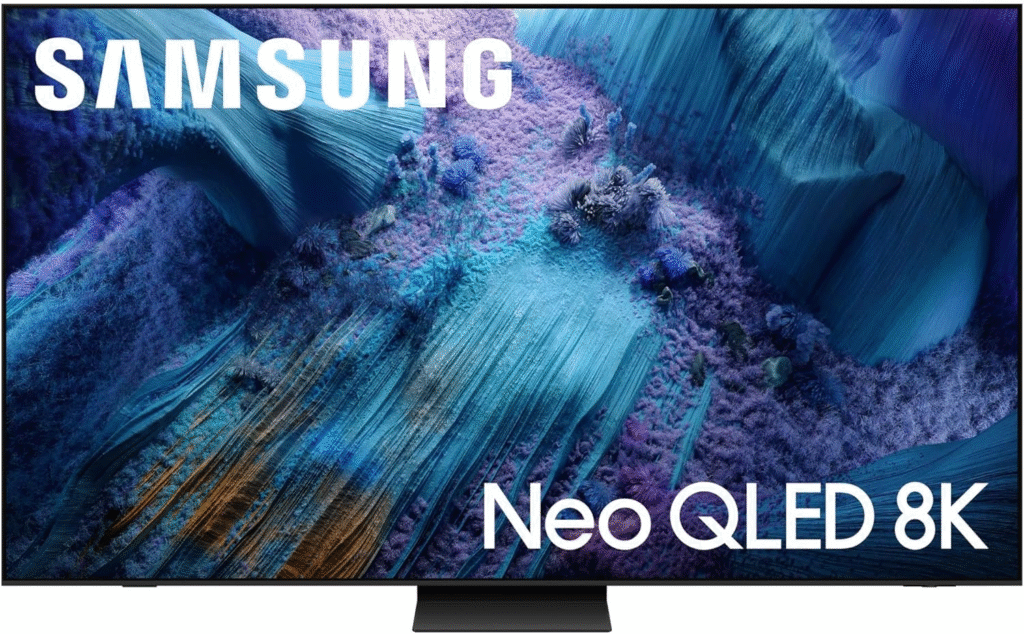
Step 2: Choosing Your Core Gear – The Essentials Explained
Core Component #1: Headphones (Your Personal Sound Bubble)
- Headphones 101: Types Demystified
- Over-Ear: Cups enclose ears. Best comfort/sound generally.
- Closed-Back: Seal in sound (noisy places/privacy), often more bass.
- Open-Back: Sound leaks in/out. Wider, natural soundstage (“airiness”). Best for quiet spaces.
- On-Ear: Pads sit on ears. More portable, less comfy long-term, less isolation.
- In-Ear Monitors (IEMs): Snug fit in ear canal. Highly portable, excellent isolation. Perfect for portable audio setup beginner.
- (Keywords: “beginner headphone types explained,” “closed back vs open back simple”)
- Over-Ear: Cups enclose ears. Best comfort/sound generally.
- Choosing Your First Pair: Comfort & Compatibility First
- Comfort is KING: If they hurt after 30 minutes, you won’t use them. Prioritize reviews mentioning comfort. Try them if possible!
- Sound Signature: For first headphones, seek “balanced” or “neutral” – avoids extreme bass/treble fatigue. “Consumer-friendly” often means slightly boosted bass.
- Impedance & Sensitivity (Simplified):
- Low impedance (< 50 ohms) + High Sensitivity = Loud enough from phone/laptop. Do headphones need amp beginner? Usually not!
- High impedance (> 80 ohms) or Low Sensitivity might need a separate amp. Stick to beginner-friendly models initially.
- (Keywords: “how to choose first headphones,” “comfortable headphones beginner”)
- Recommendations: Research best headphones under $100 beginner or beginner audiophile headphones. Brands like AKG, Sennheiser, Audio-Technica offer great entry points.
CLICK HERE FOR YOUR HEADPHONES NEEDS
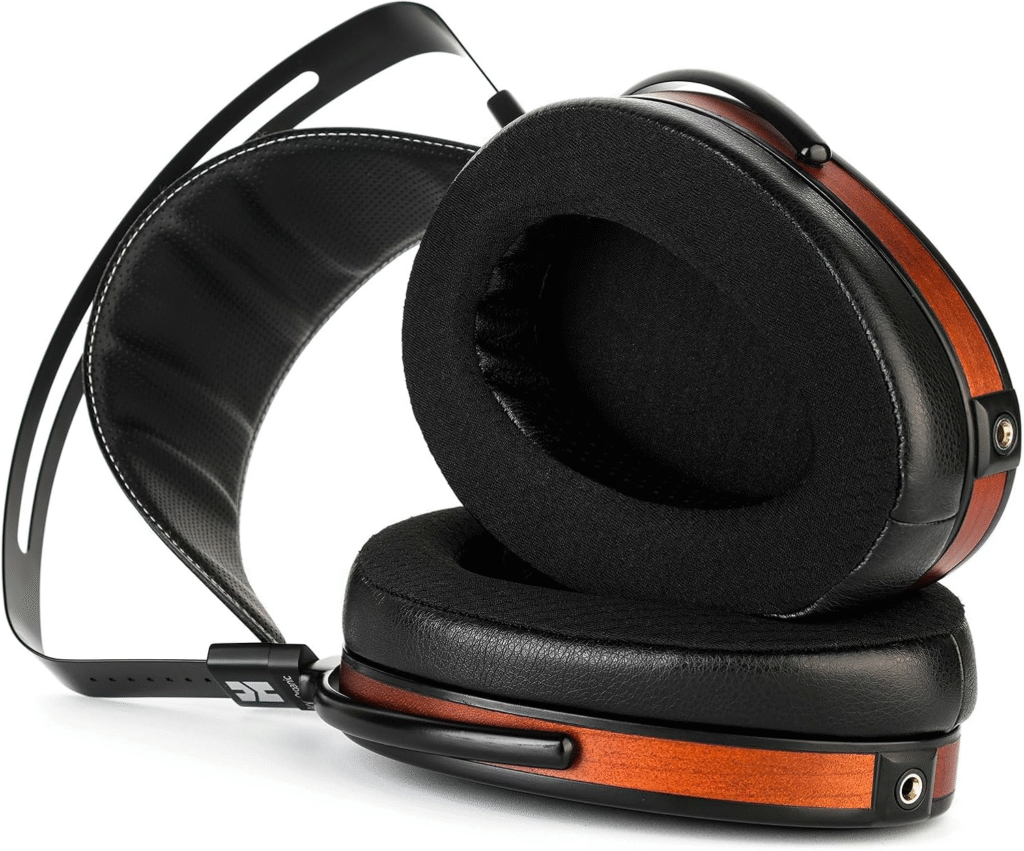
Core Component #2: Speakers (Filling Your Space)
- Speaker Types Made Simple:
- Bookshelf Speakers: Versatile for desktop audio setup beginner or small room speaker setup. Sit on desks, shelves, stands. Usually need an amp.
- Soundbars: Simplest TV sound upgrade. One bar (+ subwoofer often). Easy setup.
- Tower Speakers: For larger rooms needing more output/bass. Require space and a separate amp.
- (Keywords: “simple TV sound upgrade”)
- Active vs. Passive: The Crucial Distinction
- Active (Powered): Amplifier built-in. Plug and play speakers desktop dream! Connect directly to source (PC/phone/TV). Best for beginners seeking simplicity.
- Passive: Require a separate external amplifier. More flexibility long-term but adds cost/complexity. Requires matching audio gear beginner (amp power).
- (Keywords: “active vs passive speakers beginner”)
- Setting Up Basics: Position & Connect
- Positioning Matters Hugely: Acoustics start here!
- Desk: Triangle with your head. Ear level, angled inwards, on stands/pads to reduce desk vibration.
- Room: Avoid corners/walls (boomy bass). Give breathing room. Experiment!
- Connections: Keep it simple:
- 3.5mm (Aux): Standard for PCs/phones.
- RCA (Red/White): Common on older gear/amps/active speakers.
- Optical (Toslink): Digital connection for TVs/soundbars/some PCs.
- (Keywords: “how to position desktop speakers,” “connecting speakers to PC beginner”)
- Positioning Matters Hugely: Acoustics start here!
Core Component #3: DACs & Amps – The “Maybe” Gear
- Source Quality: The Foundation
- Streaming: Free tiers (Spotify Free) use more compression. Paid tiers (Spotify Premium, Apple Music Lossless, Tidal) offer higher quality. Best streaming quality for beginners starts with a standard paid tier. Don’t obsess over lossless immediately.
- File Formats: MP3 (compressed, smaller) vs. FLAC/ALAC (lossless, CD quality). Understanding audio file formats basic: High-bitrate MP3 (320kbps) or AAC is fine for beginners.
- (Keywords: “best streaming quality beginner,” “audio file formats explained simple”)
- DAC (Digital-to-Analog Converter): Converts digital files (ones/zeros) into an analog signal speakers/headphones can play. Every digital device has one built-in. (What is a DAC beginner?)
- Amplifier: Boosts the weak signal from your source/DAC to power your headphones/speakers. (What is a headphone amp? Do speakers need an amp? – Yes, passive speakers always do).
- Do YOU Need Separate Ones? The Beginner Verdict
- Reality Check: The DAC/amp built into your modern phone, laptop, or PC is usually perfectly adequate for beginner headphones and active speakers. Focus your budget on transducers (headphones/speakers) first!
- Consider Only If:
- You buy specific “hard-to-drive” headphones.
- You hear noticeable hiss/static from your PC (budget DAC amp for PC can fix).
- You upgrade to passive speakers (need an amp!).
- Bottom Line: Do I need a DAC amp beginner? Start without. Address issues if they arise with a budget DAC amp for headphones later. Don’t pre-buy!
CLICK HERE FOR BOOKSHELVES SPEAKERS
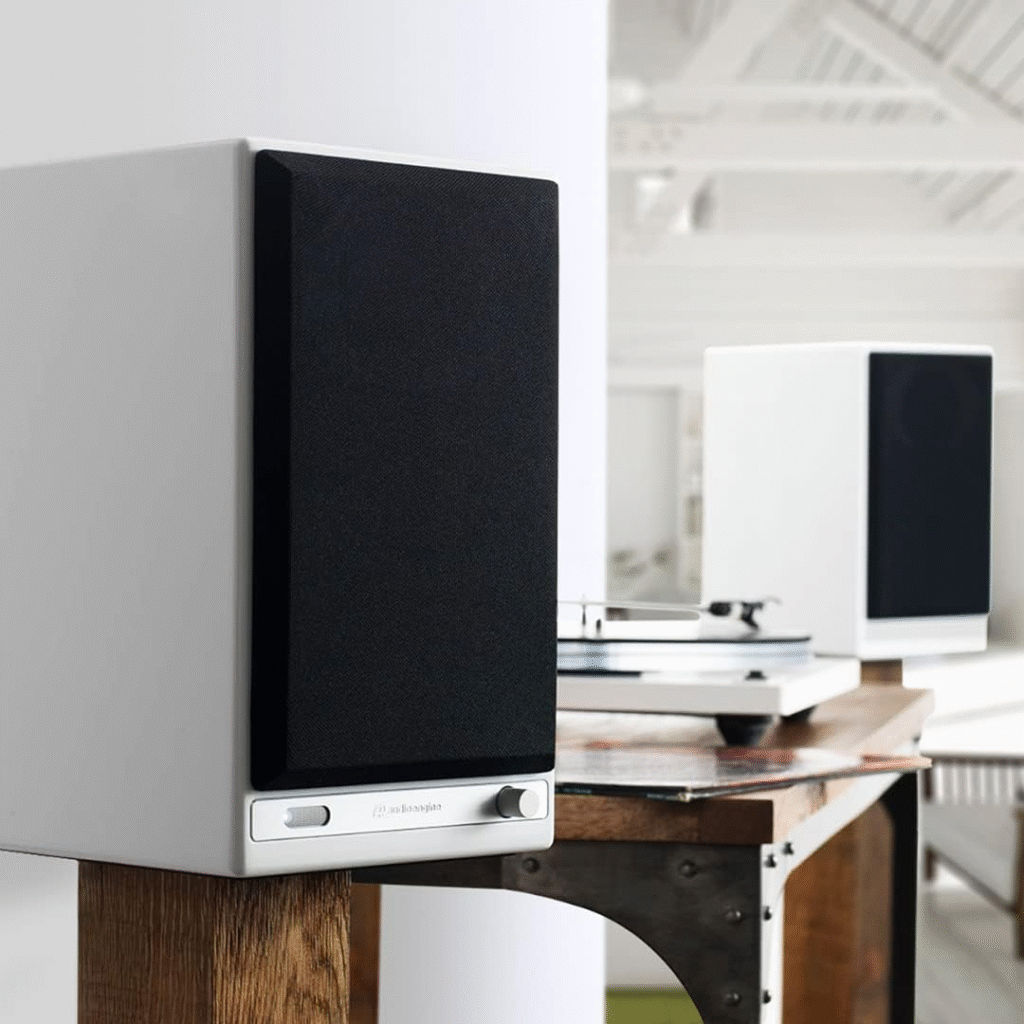
Helpful Extras: Keep It Functional
- Cables: Avoid expensive “audiophile” myths. Get correct type/length with decent build (AmazonBasics, Monoprice fine). Essential audio cables beginner just means reliable connections.
- Stands & Isolation:
- Speaker Stands/Pads: Elevate to ear level and decouple from surfaces. Cleans up bass/imaging. (speaker isolation pads beginner)
- Headphone Stand/Hook: Protects investment, prevents cable tangles/deformation. (headphone stand benefits)
Customizing Your Setup: Finding the Perfect Fit
Achieving great sound means tailoring your setup to your space and style. Think of your room as part of the system.
- Room Acoustics: Hard surfaces (tile, wood) cause sound to bounce (reverberation). Soft surfaces (carpet, curtains, plants, bookshelves) absorb sound, reducing echo and creating a more balanced experience. Experiment!
- Optimizing Placement: Crucial for speakers. Follow positioning basics. Avoid corners unless designed for it. Find the “sweet spot” through experimentation. Use calibration apps if available.
- Tailor to Taste: Enjoy bass-heavy music/movies? A subwoofer adds depth. Love vocals/jazz? Prioritize clarity in the midrange. Customizing isn’t just about the room, but aligning with what you love.
Putting It All Together: Example Beginner Setups
Let’s translate theory into practical simple home audio system setup examples:
- Scenario 1: The Desktop Listener (Music/Gaming) – Budget: ~$150-$250
- Focus: Simple PC audio setup beginner.
- Core Gear: Choose ONE:
- Headphones: Comfy closed-back (e.g., AKG K361, Audio-Technica ATH-M30x).
- Speakers: Affordable active bookshelves (e.g., Edifier R1280DBs, Creative Pebble Pro).
- Connection: Direct to PC via 3.5mm/USB.
- Extras: Basic cable, maybe isolation pads. (Keywords: “desk speaker and headphone combo”)
- Scenario 2: The Living Room Listener (Movies/Music) – Budget: ~$200-$400
- Focus: Beginner home theater audio, better TV sound.
- Core Gear:
- Soundbar: With subwoofer (e.g., Vizio V-Series, Yamaha SR-B20A). OR
- Passive Setup: Basic bookshelf speakers (e.g., Micca MB42X) + Simple amp (e.g., Fosi Audio BT20A) + Speaker Wire.
- Connection: Soundbar: HDMI ARC/Optical. Amp: Optical/RCA from TV. (Keywords: “budget TV sound upgrade”)
- Scenario 3: The On-The-Go Listener – Budget: ~$50-$150
- Focus: Portable audio setup beginner.
- Core Gear:
- Headphones/IEMs: Quality wired IEMs (e.g., Moondrop Chu II, Truthear Hola) or portable headphones (e.g., AKG K361).
- Optional: USB-C/Lightning Dongle DAC (e.g., Apple dongle, JCally AP10) if phone jack is poor/missing.
CLICK HERE FOR DEALS ON PROJECTORS
Avoid These Common Beginner Pitfalls
- Overspending on the Wrong Thing: Don’t buy a $300 DAC for $80 headphones. Focus budget on core transducers first.
- Ignoring Comfort: Uncomfortable gear gathers dust, especially headphones.
- Spec Sheet Overload: Impedance, THD, frequency graphs matter more later. Start with needs and reviews.
- Source Neglect: Avoid ultra-low bitrate streams/files (e.g., 96kbps MP3). Standard streaming quality is fine initially.
- Poor Positioning: Great speakers sound awful if placed badly. Take time to set them up correctly! (Keywords: “beginner audio setup mistakes,” “audio buying pitfalls”)
Tips for Maintaining Your Audio Equipment
Protect your investment for longevity and peak performance:
- Dust Control: Use a soft brush or compressed air monthly. Dust hinders performance.
- Moisture is the Enemy: Keep gear dry. Avoid placement near open windows, kitchens, or bathrooms.
- Power Protection: Use a surge protector. Voltage spikes can kill electronics.
- Cable Care: Avoid sharp bends and tugs. Secure cables neatly to prevent damage.
- Replace Worn Parts: Swap out frayed headphone pads or damaged speaker grilles to maintain sound quality.
- Software Updates: Keep firmware/software current for digital components for optimal performance and bug fixes.
A Glimpse Ahead: The Future of Audio
Audio tech is always evolving, bringing exciting possibilities for beginners:
- Wireless Fidelity: Bluetooth codecs like aptX Adaptive and LDAC are closing the gap on wired sound quality.
- Immersive Audio: Formats like Dolby Atmos and DTS:X are becoming more accessible, offering breathtaking 3D soundscapes for movies, music, and gaming.
- Smarter Integration: Voice assistants and multi-room audio (like Sonos, Wiim) make controlling whole-home sound seamless.
- Personalized Sound: Emerging tech adapts audio to individual hearing profiles for a tailored experience.
- Sustainability Focus: Expect more eco-friendly materials and energy-efficient designs.
Your Sound Journey Begins!
Finding your perfect beginner audio setup is about understanding your unique listening habits, space, and budget, then making simple, informed choices. Start with your core needs – source, location, content, budget. Choose headphones or speakers that fit comfortably. Remember, built-in audio is often good enough to start – avoid unnecessary DACs/amps initially.
Upgrade gradually. Enjoy the music, movies, or games first. As you listen, you’ll naturally notice what you want to improve. Then research specific upgrades. Welcome to the world of better sound! Trust your ears, enjoy the discovery, and remember: the best setup is the one that moves you. Now, put on your favorite track and appreciate the difference!
Affiliate Disclosure: This article contains affiliate links. If you click through and make a purchase, I may earn a commission at no additional cost to you. As an affiliate, I only recommend products and services I genuinely trust and believe in.09

